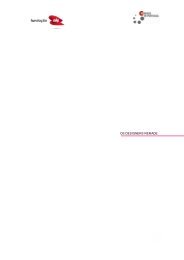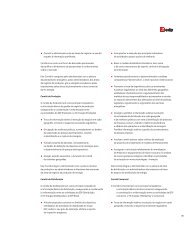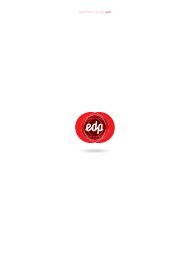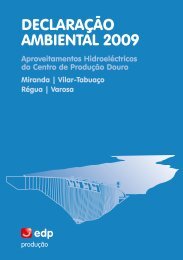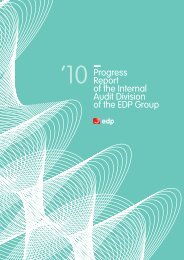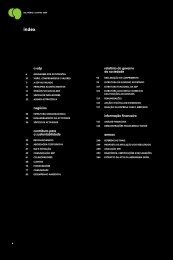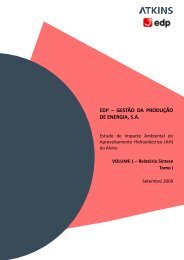Annual Report - EDP
Annual Report - EDP
Annual Report - EDP
- No tags were found...
Create successful ePaper yourself
Turn your PDF publications into a flip-book with our unique Google optimized e-Paper software.
notes to the consolidated <strong>EDP</strong> and - Energias company de Portugal, financial S.A. statementsfor the years Notes to the ended Consolidated 31 december and Company 2012 Financial and Statements 2011for the years ended 31 December 2012 and 2011Hedge accountingThe Group uses financial instruments to hedge interest rate risk, exchange rate risk and price risk resulting from its operational and financing activities. Derivatives notqualified for hedge accounting under IAS 39 are accounted for as trading instruments.Hedging derivatives are recorded at fair value, being the gains and losses recognised in accordance with the hedge accounting model applied by the Group. Anhedge relationship exists when:(i) At the inception of the hedge there is formal documentation of the hedge;(ii) The hedge is expected to be highly effective;(iii) The effectiveness of the hedge can be reliably measured;(iv) The hedge is revalued on an on-going basis and is considered to be highly effective throughout the reporting period;(v) The forecast transaction being hedged must be highly probable and must be exposed to changes in cash flows that could ultimately affect profit or loss.Fair value hedgeChanges in the fair value of derivatives that are designated and qualify as fair value hedges are recorded in the income statement, together with any changes in thefair value of the hedged assets and liabilities or group of hedged assets and liabilities that are attributable to the hedged risk. When the hedging relationship ceasesto comply with the requirements for hedge accounting, the accumulated gains or losses concerning the fair value of the risk being hedged are amortised over theresidual period to maturity of the hedged item.Cash flow hedgeChanges in the fair value of derivatives qualified as cash flow hedges are recognised in reserves.The cumulative gains or losses recognised in reserves are reclassified to the income statement when the hedged item affects the income statement.When a hedging relation of a future transaction is discontinued, the changes in the fair value of derivative recognised in reserves remain recognised in reserves untilthe future hedged transaction occurs. When the future transaction is no longer expected to occur, the cumulative gains or losses recognised in reserves are recordedimmediately in the income statement.Net investment hedgeThe net investment hedge model is applied on a consolidated basis to investments in subsidiaries in foreign currencies. This model permits that the exchangedifferences recognised in the exchange differences consolidated reserves to be offset by the foreign exchange differences in foreign currency loans or currencyderivatives contracted. The ineffective portion of the hedging relationship is recognised in the income statement.The accumulated foreign exchange gains and losses regarding the net investment and the related hedging instrument recognised in equity are transferred to theincome statement when the foreign entity is sold, as part of the gain or loss resulting from the disposal.EffectivenessFor an hedge relationship to be classified as such, in accordance with IAS 39, its effectiveness must be demonstrated. Therefore, the Group performs prospective testsat the inception date of the hedge and prospective and retrospective tests in each balance sheet date, to demonstrate its effectiveness, showing that any adjustmentsto the fair value of the hedged item attributable to the risk being hedged are offset by adjustments to the fair value of the hedging instrument. Any ineffectiveness isrecognised in the income statement in the moment that occurs.e) Other financial assetsThe Group classifies its other financial assets at acquisition date, considering the underlying purpose, in the following categories:Financial assets at fair value through profit or lossThis category includes: (i) financial assets held for trading, acquired for the purpose of being traded in the short term, and (ii) financial assets designated at fair valuethrough profit or loss at inception (fair value option).Available-for-sale investmentsAvailable-for-sale investments are non-derivative financial assets which: (i) the Group intends to hold for an undetermined period of time, or (ii) are designated asavailable for sale on initial recognition.Initial recognition, measurement and derecognitionPurchases and sales of: (i) financial assets at fair value through profit or loss, and (ii) available-for-sale investments, are recognised on the trade date, which is the dateon which the Group commits to purchase or sell these financial assets.Financial assets are initially recognised at fair value plus transaction costs except for financial assets at fair value through profit or loss, in which the transaction costsare recognised directly in the income statement.Financial assets are derecognised when: (i) the contractual rights to receive their future cash flows have expired, (ii) the Group has transferred substantially all risks andrewards of ownership or (iii) although retaining some, but not substantially, the risks and rewards of ownership, the Group has transferred control over the assets.180A World Full Of Energy







